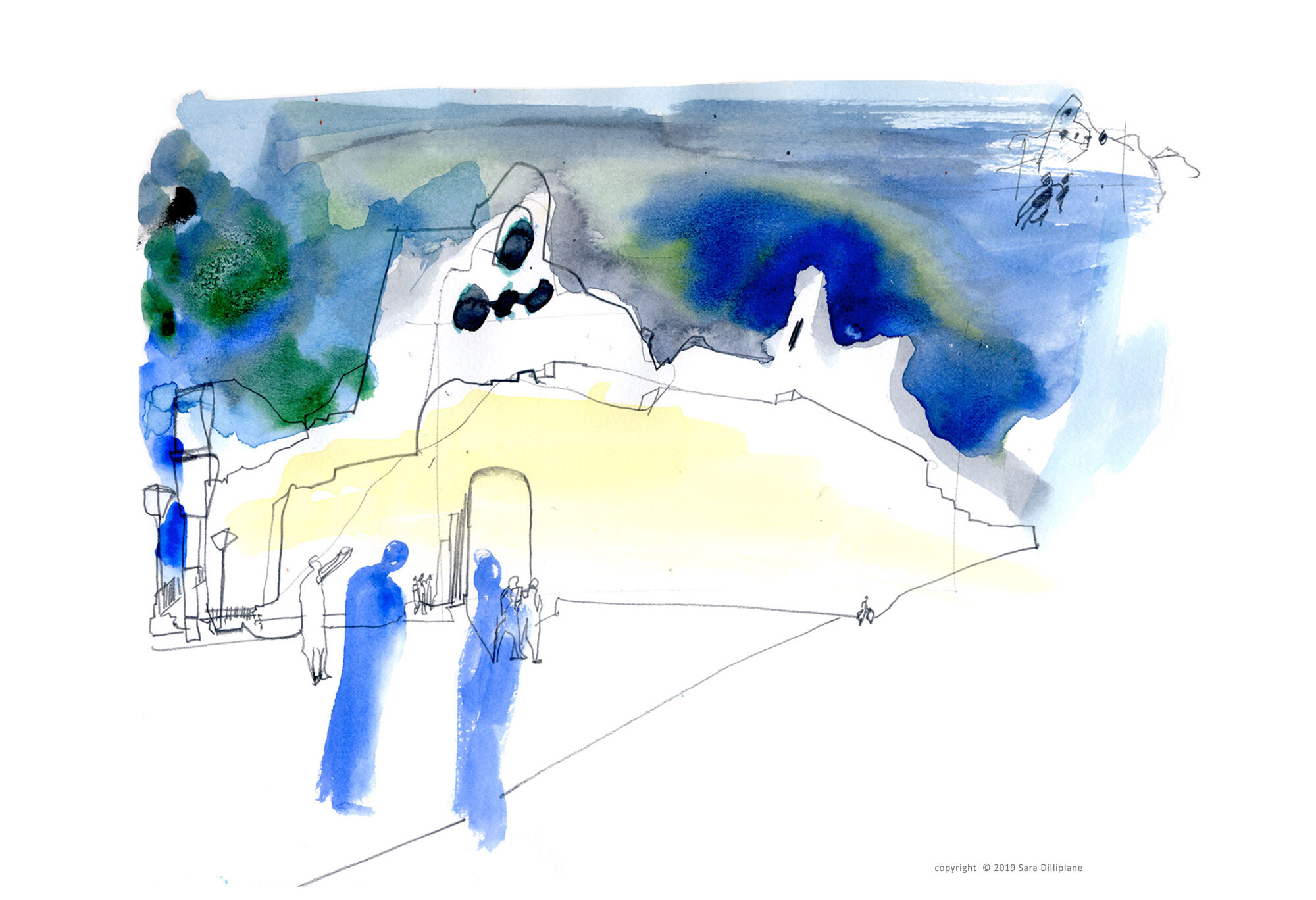It has been a busy fall so I just now had the chance to post these travel drawings… but some part of my mind is still back in this wonderful country!
Back in September, I had the opportunity to take a short trip to Greece with my husband - it was like a dream come true! I used to imagine jumping into the pictures of my elementary school history book and walking among those giant marble columns at the top of the Acropolis. Maybe it was growing up in Boston, with its reminders of American democratic origins in practically every cobblestone, I liked to think about the place where those ideas were first born.
We spent our first few days in Athens, where the jet lag and excitement fused into a kind of star-struck daze of amazement that I was standing where Athena was worshiped and Julius Caesar once orated. We made a beeline for the Acropolis Museum and then the site itself with the weather being dramatically cloudy, casting shadows that made the landscape feel vast and enough for all those Greek gods. The crown jewel on the hill, the Parthenon, was encased in scaffolding and construction workers hammered away, trying to protect this icon from being eroded by weather, politics, and pollution. Even though only parts of the Parthenon and fellow Acropolis structures are left today, they still powerfully express the glory and heroic conviction of Classical Athens and its protector god, Athena, to whom the Parthenon is dedicated. Although today this usually translates into manic selfies, people continue to be deeply moved by the crumbling majesty of this ancient civilization.
The hills leading up to the top of the Acropolis, called the slopes, are full of sacred fountains, caves, and sanctuary sites in which rites would take place honoring various gods. These areas symbolized a kind of middle ground between the worlds of mortals and the gods, where the two could meet and Athenians could ensure a dominant place in their Hellenic world. I wonder if this is why I saw so many tourists wanting to reach out and touch the marble columns - you do feel after hiking to the very top of the Acropolis, that you are somehow standing on the top of the world.
The Panathenaic Way leading to the top of the Acropolis actually extends for miles down into an area called the Roman Agora, the center of social and political life during Roman rule. This area once held the main government buildings; visible in the distance is the Parthenon, as if Athena herself was always keeping an eye on things. During the Panathenaic Festival, people would start down this path, slowly making their way past civic buildings, theaters, and sanctuaries, to take part in athletic contests, concerts, and religious rites to honor the patron goddess Athena and celebrate the strength of her people.
Wandering around the Agora, I came across the jail where Socrates was probably poisoned, and a historical layer from a much more modern time, this lovely Church of the Holy Apostles built around 1000AD.
By Day 3, we were already cranky with the unrelenting parade of tourists, so we skipped Santorini and headed to the island of Aegina instead. Here we found the beautiful beaches and the remains of the Temple of Apollo, built around 500BC, which was also a great lookout spot in those days for intruders and looters entering the port. A few miles outside the modern day town center, we came across the little village of Pachia Rahi with streets so narrow a single car barely fit through. I sat on a corner and drew this little church, Archangels (built in 1809), where the only sounds for miles were birdsong and someone’s radio broadcasting a soccer match through an open window.
Later we hiked to the top of the tallest mountain on the island, Ellanios Oros, where Zeus was once worshipped by inhabitants. A church still stands on the spot where Zeus’ son, Aeacus went to pray for the end to a long drought. Since his prayers were answered, a shrine was built dedicated to Zeus and the amazing views still definitely feel reverential.
The next day, we drove north to Delphi, the original prophetic center of the Greek world (the root of the word “delphi” is delphys, "womb"). The history of this site is chock full of story and symbolism - and there is an otherworldly aura that still floats in the air and everyone respects. Even the hoards of international tour groups remained their best quiet library behavior.
This sacred site was where Zeus saw two eagles in flight cross paths, their point of intersection marking the center of the earth. Greeks believed this center, or navel, was where all wisdom could be found and leaders from city-states across the Greek world came seeking answers to military and diplomatic questions. Points along the pathway to the top of the mountain were lined with countless offerings (gifts of art, money), and shrines to stop and pay respect to the gods Apollo (god of light, healing, truth) and Athena (wisdom, warfare).
Visitors seeking advice would eventually make their way to Sibyl’s Rock, which today is marked by a tree. An oracle, always an older peasant woman from the nearby community, who became possessed by the spirit of Apollo when sitting at this spot marking the center of the earth. Through the oracle, Apollo would advise on matters big and small like an ancient magic 8 ball.
Keeping with the theme of diplomatic gathering spot, the precursor to the Olympic games, the Pythian games, were first held here: a sacred place to put aside political views and conduct games with a mutual promise fair play and respect. At the very top of the mountain, where the outdoor stadium held track meets and medal ceremonies, you got a perfect view of the spot where Zeus spotted the two eagles crossing: what a beautiful symbol of opposite sides coming together in cooperation.
Our last stop before leaving Greece was a further drive north up to the beautiful mountains of Meteora. Giant rock formations sprawl for miles like a Baltic Grand Canyon, as if sculpted by some divine being from the pantheon of Greek gods.
Meteora means “of the air,” and in the 1300s, priests began building monasteries on these mountaintops. The challenge of hauling materials up this high was justified by the safety offered from religious persecution, and spiritually it allowed people to be closer to their god. Suspended high above the ground, priests could carry out religious study in peace; this practice continues today with a small number of priests or nuns living in these surviving monasteries.
We visited four of these, all quietly offering a peek into the monastic life of devotion and integrity.
Even with the pile up of tour buses and selfie-crazed tourists, it was beautiful.
On our last night in Meteora, we heard a beautiful performance from two musicians, one who played the traditional bouzouki guitar, at a local restaurant. Everyone was laughing and arguing, sharing food, dancing. The whole place felt like a big family.
On the way back to the hotel, our taxi driver asked us what we thought of Greece and before we could answer, he started laughing: “You know, we Greeks are crazy - we’re always fighting but then we go out for coffee afterwards. I think this is how we’re able to survive after all this time!”
I agree… what an influential, contradictory, and incredibly enduring country! I can’t wait to go back.















